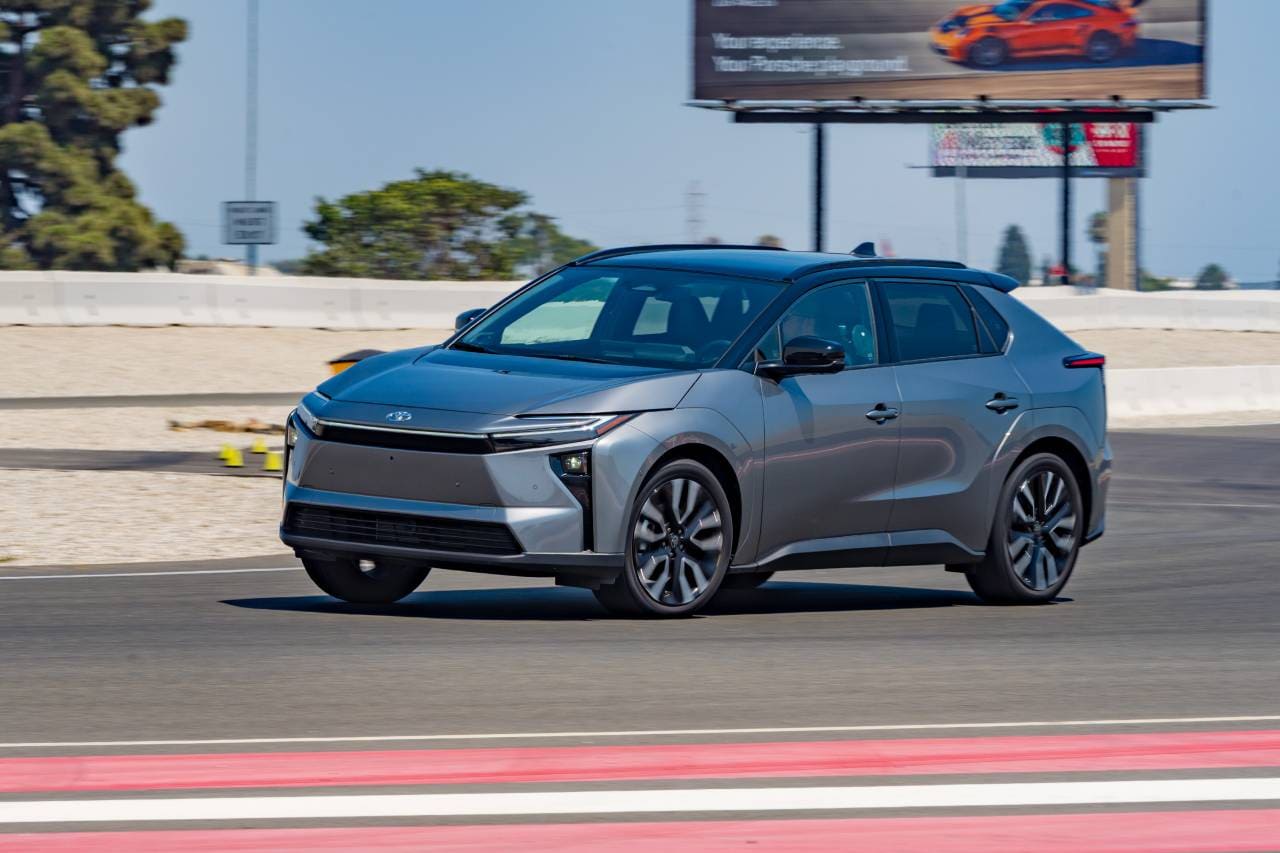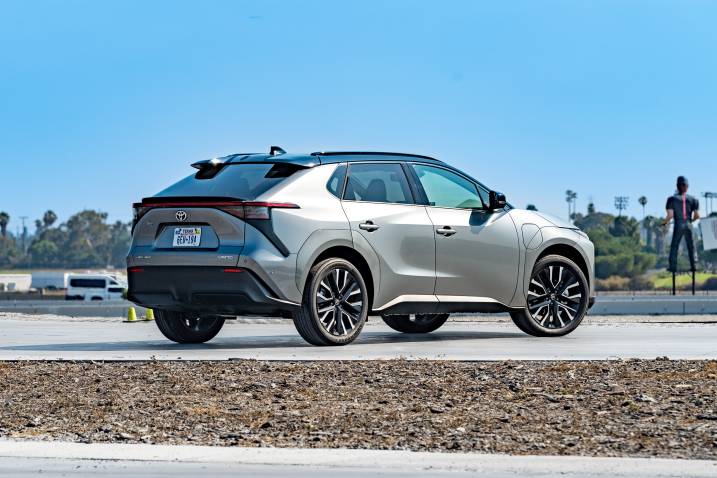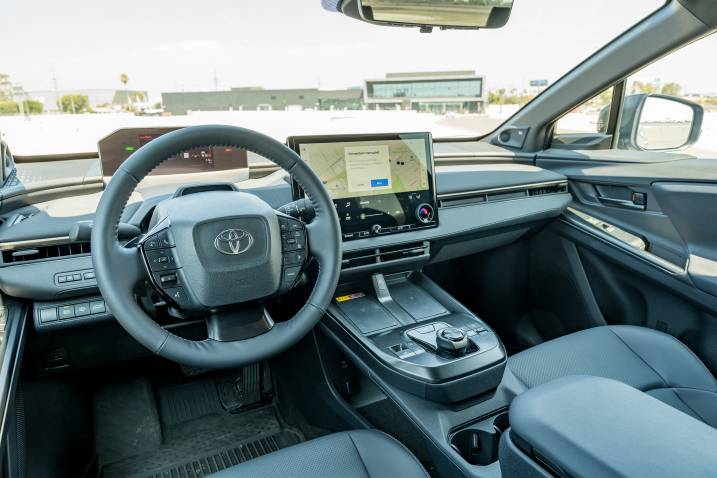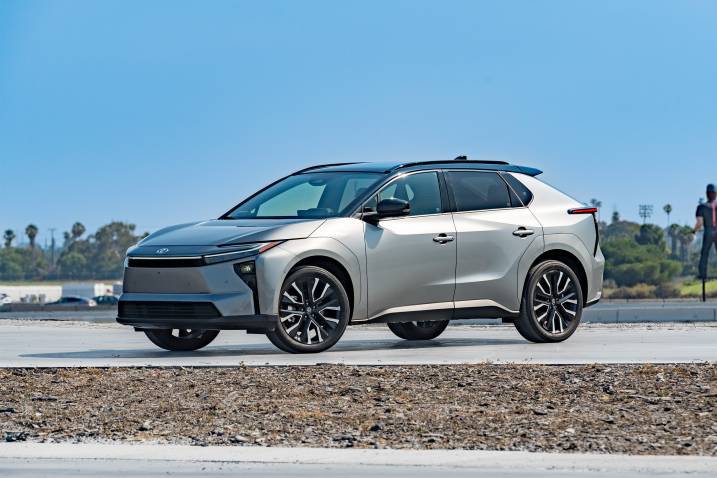- We tested a prototype version of the Toyota bZ on our test track and also put it through the Edmunds EV Range and Charging tests.
- Its predecessor, the bZ4X, didn't have nearly enough range or performance for its cost.
- Styling and the SUV's interior have also improved.
Tested: 2026 Toyota bZ Goes Farther, Faster
The bZ4X was too slow and lacked range to keep up with competitors. Has that changed?
Toyota arrived late to the electric vehicle game and, to be frank, it showed up with a dud. The bZ4X had a strangely complicated name, subpar range, and a serious lack of performance for how much it cost. And its styling was ... strange, to put it delicately.
So Toyota has gone back to the drawing board and come back with this, the all-new bZ. That's right, the last two characters have been lopped off the name, but don't let that similarity fool you: It's back with over 50% more horsepower for all-wheel-drive models and a more than 50-mile bump in estimated range. Changes like that get our attention, as do positive styling updates like getting rid of all of that awful black cladding across the front fenders and bumper. And so we were excited to welcome the newly christened electric SUV to our track.
2026 Toyota bZ prototype | Edmunds Test Results |
|---|---|
| Motor | dual electric motors |
| Power | 338 hp |
| Torque | N/A |
| Transmission | single-speed automatic |
| Driveline | AWD |
| Weight | 4,490 pounds |
| 0-60 mph | 4.6 seconds |
| Quarter mile | 13.1 seconds @ 101.4 mph |
| 60-0 mph braking | 122 feet |
| Lateral grip (200-foot skidpad) | 0.86 g |
| Price as tested | $46,750 (est.) |
Mo' power, no mo' problems?
That bump from 214 hp to 338 hp for AWD models had the intended effect on the bZ's 0-60 mph time. It's properly quick now, with no qualifiers needed, completing the sprint from 0 to 60 mph in just 4.6 seconds and covering the quarter mile in 13.1 seconds at a trap speed of 101.4 mph. And it would have done the quarter even quicker if it hadn't hit its top speed limiter before crossing the finish line.
We didn't get to have an AWD version of the bZ4X in for testing, so we can't quite do an apples-to-apples comparison. But the single-motor front-wheel-drive version took 7.3 seconds to get from 0 to 60 mph, and the AWD version used to only make 13 horsepower more, so its time wasn't likely to come anywhere close.
The most instructive way to assess the bZ's test results is to compare them to the performance of two of its closest competitors: the dual-motor versions of the Hyundai Ioniq 5 and Honda Prologue.
Toyota bZ vs. Hyundai Ioniq 5 vs. Honda Prologue
Test | Toyota bZ (AWD) | Hyundai Ioniq 5 (AWD) | Honda Prologue (AWD) |
|---|---|---|---|
| 0-60 mph | 4.6 seconds | 4.9 seconds | 6.2 seconds |
| Quarter mile | 13.1 seconds @ 101.4 mph | 13.4 seconds @ 99.9 mph | 14.7 seconds @ 92.3 mph |
| 60-0 mph braking | 122 feet | 121 feet | 127 feet |
| Lateral grip (200-ft skidpad) | 0.86 g | 0.87 g | 0.84 g |
| Weight | 4,490 pounds | 4,789 pounds | 5,270 pounds |
As you can see, the bZ is now quicker than both of those vehicles (especially the Honda, goodness gracious) and posts comparable skidpad and braking figures to the Ioniq 5, a vehicle that we've lauded for its dynamics. The bZ still doesn't feel quite as agile as the Hyundai; it has more body roll and a tendency to get squirrelly at the rear under heavy braking. But at least it can now credibly participate in the conversation.
Range and charging test results
Up next, it was time for the bZ to take a turn on the world-famous Edmunds EV Range Test to see if that part of the equation had also been solved. The bZ does get a slightly larger battery than the bZ4X, upping capacity to 74.7 kWh from 72.8 kWh. But that 2.6% gain doesn't explain why it suddenly has a 25% increase in estimated range, jumping from an EPA-estimated 222 miles to 278 miles. Not to mention the fact that it also has more powerful motors that somehow seem to be more efficient. We reached out to Toyota to see what wizardry might be at work, and this was its response:
"Battery capacity has been increased and new eAxles with compact, lightweight and energy-efficient silicon carbide (SIC) semiconductors have been adopted, reducing energy loss and enhancing both cruising range and power consumption."
Cool.
Explanations aside, the numbers would tell the tale, and we were hopeful that the bZ might join the 300-mile club because the FWD bZ4X we tested beat its estimated range by 20 miles. But after a full day behind the wheel, the bZ couldn't repeat those results — it covered 276 miles, barely missing its estimate. This is still a gigantic improvement and, to again contextualize, comes close to the 282 miles the Ioniq 5 AWD put up on our test a month earlier.
The issue for the bZ remains charging speed, as we noted a peak charging speed of just 160 kW. That's why even though the bZ is more efficient than the Hyundai and uses 28.3 kWh/100 miles (versus 32.4 kWh/100 miles for the Ioniq 5), it falls far behind on our leaderboard, adding in 410 miles of range per hour. To be clear: That's a better result than we got in the Prologue (328 miles), or even other compact electric SUVs like the Volkswagen ID.4 (328 miles again) and Ford Mustang Mach-E (269 miles). And it just about ties the new Tesla Model Y (403 miles), but the Ioniq 5's 696 miles of range per hour is still king among this group.
Mission accomplished
It used to be the case that if you were buying a bZ4X, you would have to accept getting less range and performance than you'd get with similarly priced and sized vehicles. But now that it's on a level playing field (or even ahead) on those metrics, we can evaluate the Toyota more on its other merits like a roomy and comfortable back seat, solid cargo room and driver aids. Given where it was coming from, this update to the bZ was more about catching up than getting ahead — and it's safe to say that goal has been achieved.








 by
by  edited by
edited by